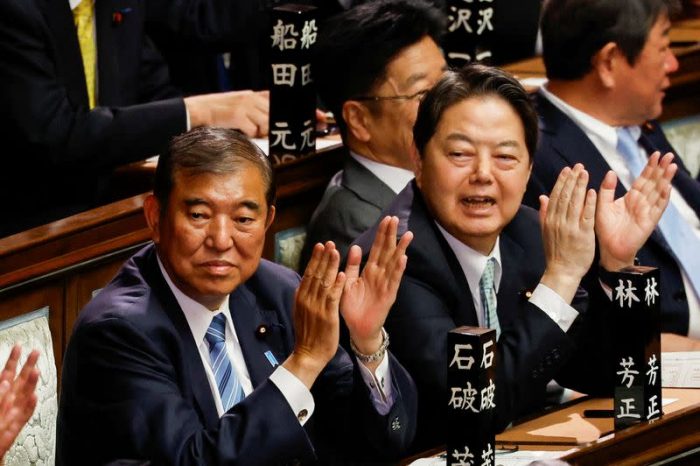Japan’s prime minister Shigeru Ishiba won a parliamentary vote on Monday that will see him remain as the country’s leader.
Ishiba’s position was in doubt after his coalition, which was tarnished by a slush-fund that brought down his predecessor Fumio Kishida, lost its parliamentary majority in a lower house election last month.
He called a snap poll after taking office on October 1, but must now run a fragile minority government as protectionist Donald Trump returns to office in main ally the United States, while tension rises with rivals China and North Korea, and domestic pressure mounts to rein in the cost of living.
ALSO SEE: Toyota Keen to Bolster Output With Chinese Partners: Sources
His Liberal Democratic Party and coalition partner Komeito won the biggest bloc of seats in the election but lost the majority held since 2012, leaving him beholden to small opposition parties to pass his policy agenda.
Underlining that fragility, Monday’s vote in parliament, broadcast on television, went to a runoff for the first time in 30 years, with no candidate able to muster majority support in the first round.
But Ishiba eventually prevailed as expected, garnering 221 votes, well clear of his nearest challenger, ex-PM Yoshihiko Noda, the head of the main opposition Constitutional Democratic Party, but still short of a majority in the 465-seat lower house.
Japan will hold elections next year for the less powerful upper house, where the ruling coalition’s slim majority could also be at risk if Ishiba cannot revive public trust roiled by a scandal over unrecorded donations to lawmakers.
Extra budget, trips to US, G20 eyed
His imminent challenge is compiling a supplementary budget for the fiscal year through March, under pressure from voters and opposition parties to raise spending on welfare and take steps to offset rising prices.
For approval he needs the backing of at least one opposition party, which is most likely to be the Democratic Party for the People (DPP) headed by Yuichiro Tamaki.
He has held cooperation talks with Ishiba, but DPP lawmakers on Friday did not vote for Ishiba to stay on as prime minister.
Tamaki is also in a precarious position after admitting Monday to an extra-marital affair revealed in a tabloid magazine.
With his premiership confirmed Ishiba appointed three new cabinet ministers, one each for transport, justice and agriculture, two of whom replace LDP lawmakers who lost their seats in the lower house election.
Ishiba now has to prepare for a slate of international engagements, including a summit of the Group of 20 big economies in Brazil on November 18 and 19.
He is also trying to arrange a stopover in the US on the way to or from that gathering to meet Trump. The Japanese leader spoke to the president-elect for the first time on Thursday in a “friendly” five-minute conversation during which he congratulated him on his election victory.
Some Japanese officials nonetheless fear Trump might again hit Tokyo with protectionist trade measures and revive demands for it to pay more for the cost of stationing US forces there.
These issues were largely smoothed over in Trump’s first term, from 2017 to 2021, by the close ties between the president and Japan’s then-premier, Shinzo Abe – a bond Ishiba seems keen to re-establish.
BOJ to monitor climate risks
Meanwhile, the Bank of Japan (BOJ) hopes to maintain its 2% inflation target even if climate change causes long-term shocks to future price developments, Governor Kazuo Ueda said on Saturday.
Ueda said the BOJ would “monitor carefully” how the economic impact of climate change, as well as the fallout from government measures to promote the green transition, could affect inflation expectations.
“We would like to keep the inflation target at the current level”, even if climate change shocks occur, Ueda said at a conference in Basel, monitored via a live YouTube feed. “But I of course worry what it will do to inflation expectations.”
Japan will likely introduce a carbon tax sometime in the future, which could affect inflation expectations, Ueda said at the event, held to discuss the impact of climate change on the economy and monetary policy.
Government subsidies to promote the green transition may also create inflationary pressure in the short term, although Japan can “accommodate such inflationary forces for a while”, as underlying inflation was currently still below 2%, he said.
Under its green transition strategy, the Japanese government will provide fiscal support worth 20 trillion yen ($131 billion), or 3% of the country’s gross domestic product (GDP), to companies investing in environment-friendly technology over the next 10 years.
In the second phase of the strategy, the government plans to introduce carbon pricing and operate a fully fledged emissions trading system in fiscal 2026, and to impose a fossil fuels surcharge in fiscal 2028.
The conference was co-organised by the Bank for International Settlements, the BOJ, the Bank of Spain and the Network for Greening the Financial System.
- Reuters with additional editing by Jim Pollard
ALSO SEE:
Yen Drops as Japan Faces Delay Over Form of New Government
Former Defence Minister Shigeru Ishiba to be Japan’s Next PM
Japanese PM Kishida Says He Will Resign Next Month
Japan Now Asia’s Top Choice For Hedge Funds as China Falters
Japan’s Economy Grew 3.1% in 2nd Quarter on Consumption Rise
Hedge Funds Boost Japan Allocations, China Stocks at 5-Year Low
Bank of Japan in Rare Rate Rise, Bond Taper Plan Unveiled
Bank of Japan Seen Hinting at Rate Hikes Next Month
Bank of Japan Ends Negative Rates, as Ueda Normalises Policy
























